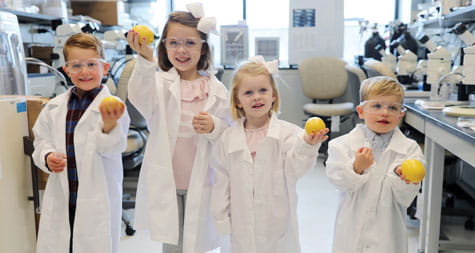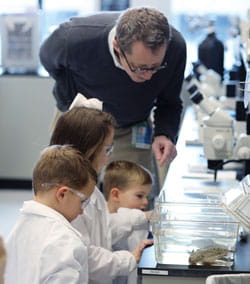Recipe for Success
Combining community, ambition, research and philanthropy to save lives
What started as an end-of-summer lemonade stand turned into a lesson in business, gratitude, philanthropy, community and the power of science.
Jack and Beatrice, both 5 years old, have been best friends their entire lives. When they get together, good things happen—giggles, yummy treats, hugs—and life-saving science.
“Jack was asking about having a lemonade stand the entire summer,” Amanda, Jack’s mom, says. They invited their family and friends, including Bea and her sisters, to be a part of the end-of-summer celebration.
“They were so cute together,” she remembers. “They ended every sale by saying, ‘Thank you for your business!’”
The little entrepreneurs were so proud of the $148 they made. Still unsure of the value of a dollar, their parents helped guide Bea and Jack in how to best use the money. They all agreed to donate it to Cincinnati Children’s. The medical center means a lot to Bea’s family—and to so many others in our community.
Donations Save Lives
When Bea was born, she appeared to be healthy, though a bit jaundiced. When her condition worsened, her parents knew something was wrong. She was diagnosed with biliary atresia, a life-threatening liver condition. Doctors did everything they could to help her, but she needed a liver transplant.
Bea was added to the organ donor list, but time passed and a match wasn’t found.
“The worst part about the waiting list is knowing that the sickest kids have priority in receiving an organ,” Bea’s mom Hillary says. “So while you’re waiting, you’re just watching your child’s condition get worse. It’s a horrible thing to have to go through.”
Willing to do anything for her daughter, Hillary was tested and matched as a living donor—allowing her to donate a portion of her liver to Bea. And in just a few months, they were both in recovery from their surgeries.
The Power of Community
When they came to Cincinnati Children’s to donate their lemonade stand earnings, Hillary snapped a quick picture of the kids holding a big check.
“We shared the picture of the kids on our Instagram pages and asked friends to donate—maybe match the kids’ donation. And it just took off,” Hillary says. “Since Bea’s been treated there, we’ve raised money for the hospital in different ways, but I never thought this lemonade stand would go viral like it did.”
By the next morning, the post inspired $7,000 in donations. And that was just the beginning.
“It kept snowballing. It felt incredible to see all the gifts coming in,” Hillary says, her face beaming.
In less than two weeks, #LemonAID, as it came to be known, raised $205,000, garnering gifts from people all over the country and around the world—including celebrities.
"It was just mind-blowing,” Amanda says. “We knew that this money would help so many people, and would help someone who is loved as much as we love Bea. It was truly an amazing experience for our kids and both of our families."
Inspiring CuSTOM Treatments
Just like Bea and Jack, Takanori Takebe, MD, believes there’s a perfect recipe for everything. Six years ago, he developed a method to grow miniature livers in our lab.
Dr. Takebe knows the struggle families like Bea’s face. When he graduated from medical school he planned to become a transplant surgeon. But when he saw the gap between the need and the availability of donated organs, he knew he had to look for a better way to help his patients. His drive to save more lives and his innovative research are getting us there.
Wanting to help others who would benefit from work being done by Dr. Takebe and our team of experts, both Bea's and Jack's families decided to designate the donations to our ground-breaking research on organoids. These fully-functioning miniature versions of organs are made out of a patient’s own cells and are grown in our lab.
We became the first medical center to launch a center for organoid research. The Center for Stem Cell and Organoid Medicine (CuSTOM) will help us better learn how we can fully harness this new technology.
Dr. Takebe’s breakthrough cemented our belief that the future of medicine and personalized care truly begins within each body. Today, our experts can take a few cells from a patient and generate many different kinds of organoids to see how certain diseases and conditions progress, as well as find the medications and therapies that work best for each child.
With this new technology, organ donor lists could become a thing of the past—eventually we’ll be able to create new, healthy organ tissue for transplantation back into the patient.
That means no waiting and less uncertainty for families facing life-threatening conditions. And no chance of organ rejection because the healthy tissue will be created from the patient’s own cells.
For Hillary, that gives her hope that other families will be spared the heartache her family experienced, and it drives her to continually find ways to support the medical center.
“Cincinnati Children’s has given us so much more than we could ever give back,” she says. “The impact they’ve had on our family—saving our daughter—can never be repaid, but we’ll always try to do our best to show our gratitude.”
To learn more or donate, contact James Cleetus at 513-636-1166 or james.cleetus@cchmc.org.





